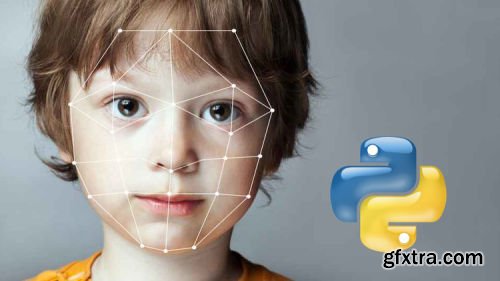
https://www.udemy.com/course/computer-vision-face-recognition-quick-starter-in-python
Python Deep Learning based Face Detection, Recognition, Emotion , Gender and Age Classification using all popular models
What you'll learn: Face Detection from Images Face Detection from Realtime Videos Emotion Detection, Age-Gender Prediction Face Recognition from Images, Realtime Videos Requirements: A decent configuration computer and an enthusiasm to dive into the world of computer vision based Face Recognition Description: Hi There! welcome to my new course 'Face Recognition with Deep Learning using Python'. This is an updated course from my Computer Vision series which covers Python Deep Learning based Face Detection, Face Recognition, Emotion , Gender and Age Classification using all popular models including Haar Cascade, HOG, SSD, MMOD, MTCNN, EigenFace, FisherFace, VGGFace, FaceNet, OpenFace, DeepFace Face Detection and Face Recognition is the most used applications of Computer Vision. Using these techniques, the computer will be able to extract one or more faces in an image or video and then compare it with the existing data to identify the people in that image. Face Detection and Face Recognition is widely used by governments and organizations for surveillance and policing. We are also making use of it daily in many applications like face unlocking of cell phones etc. This course will be a quick starter for people who wants to dive deep into face recognition using Python without having to deal with all the complexities and mathematics associated with typical Deep Learning process. We will be using a python library called face-recognition which uses simple classes and methods to get the face recognition implemented with ease. We are also using OpenCV, Dlib and Pillow for python as supporting libraries. Let's now see the list of interesting topics that are included in this course. At first we will have an introductory theory session about Face Detection and Face Recognition technology. After that, we are ready to proceed with preparing our computer for python coding by downloading and installing the anaconda package. Then we will install the rest of dependencies and libraries that we require including the dlib, face-recognition, opencv etc and will try a small program to see if everything is installed fine. Most of you may not be coming from a python based programming background. The next few sessions and examples will help you get the basic python programming skill to proceed with the sessions included in this course. The topics include Python assignment, flow-control, functions and data structures. Then we will have an introduction to the basics and working of face detectors which will detect human faces from a given media. We will try the python code to detect the faces from a given image and will extract the faces as separate images. Then we will go ahead with face detection from a video. We will be streaming the real-time live video from the computer's webcam and will try to detect faces from it. We will draw rectangle around each face detected in the live video. In the next session, we will customize the face detection program to blur the detected faces dynamically from the webcam video stream. After that we will try facial expression recognition using pre-trained deep learning model and will identify the facial emotions from the real-time webcam video as well as static images And then we will try Age and Gender Prediction using pre-trained deep learning model and will identify the Age and Gender from the real-time webcam video as well as static images After face detection, we will have an introduction to the basics and working of face recognition which will identify the faces already detected. In the next session, We will try the python code to identify the names of people and their the faces from a given image and will draw a rectangle around the face with their names on it. Then, like as we did in face detection we will go ahead with face recognition from a video. We will be streaming the real-time live video from the computer's webcam and will try to identify and name the faces in it. We will draw rectangle around each face detected and beneath that their names in the live video. Most times during coding, along with the face matching decision, we may need to know how much matching the face is. For that we will get a parameter called face distance which is the magnitude of matching of two faces. We will later convert this face distance value to face matching percentage using simple mathematics. In the coming two sessions, we will learn how to tweak the face landmark points used for face detection. We will draw line joining these face land mark points so that we can visualize the points in the face which the computer is used for evaluation. Taking the landmark points customization to the next level, we will use the landmark points to create a custom face make-up for the face image. Till now we were using the face-recognition third party library to achieve most of the functionality. But from now onwards we will try the face-recognition pipeline steps which includes face detection, face alignment, face feature extraction verification and classification separately one by one using popular libraries. We will have an introduction about these in this session. In the next session, we will start with face detection. We will divide them into traditional face detection methods and modern methods which involves CNN. At first we will try the Haar Cascade object detection algorithm for face detection. We will try it at first for still images and later we will implement it for saved videos as well as live web cam videos. Another popular algorithm for face detection is HOG or Histogram of Oriented Gradients. At first we will have an introduction to the working of HOG algorithm and then we will try the HOG method for images, videos and real-time web cam stream. The next face detection algorithm we will try is SSD or Single Shot Detection. We will repeat the same functionality exercises for SSD also. And then comes MMOD. We will repeat the same functionality exercises for SSD also. Then the MMOD, the Max-Margin Object Detection. We will repeat the same functionality exercises for MTCNN also. Then comes the next algorithm which is MTCNN, the Multi-task Cascaded Convolutional Networks. We will repeat the same functionality exercises including image, video and real time stream for MTCNN also. Finally we will have a quick comparison between the performance of these face detection algorithms. After face detection, we will go ahead with face alignment. We will use the popular Dlib library python implementation to perform the face alignment for image, video and video streams. After face alignment exercises, we will proceed with face verification and classification where the actual face recognition is happening. At first we will have an introduction about face classification. We will divide the techniques into traditional face recognition methods and modern methods which involves CNN. At first we will try the techniques Eigenface Fisherface and LBPH, the Local Binary Pattern Histogram. We will have a short introduction about these algorithms and will then proceed with preparing the image dataset for these algorithms. Then we will set up the prerequisite for them. Later we will proceed with face detection using MTCNN and preprocessing of the detected face for recognition. Then the exercises involving training with the image dataset and trying prediction for images. We will then save this model so that we can load it later and do prediction without having to go through training again. We will also try it for pre-saved videos and real time webcam stream. Once we are done with that we will have a quick comparison of the Eigenface Fisherface and LBPH algorithms. That's all the traditional ways, now we will proceed with deep learning face recognition. At first using the popular VGGNet model for face recognition called VGGface. We will have an introduction to VGG face and then we will implement VGGface face verification for images. Later we will try VGGface face verification for videos as well as realtime streams. And then we have an introduction to FaceNet, OpenFace and DeepFace Models. We will use a popular easy to use open source python face recognition framework called deepface to implement the rest of popular deep learning techniques. We will install deepface to our computer and then try it at first for face detection and face alignment. Then we will try deepface for face one to one verification. Later with few changes, we can use it for face classification which involves an one to many comparison. deepface can also be used for performing face analysis involving gender, age, emotion, ethnicity etc That's all about the topics which are currently included in this quick course. The code, images and libraries used in this course has been uploaded and shared in a folder. I will include the link to download them in the last session or the resource section of this course. You are free to use the code in your projects with no questions asked. Also after completing this course, you will be provided with a course completion certificate which will add value to your portfolio. So that's all for now, see you soon in the class room. Happy learning and have a great time.Who this course is for:Beginners or who wants to start with Python based Face Recognition Who this course is for: Beginners or who wants to start with Python based Face Recognition
TO MAC USERS: If RAR password doesn't work, use this archive program:
RAR Expander 0.8.5 Beta 4 and extract password protected files without error.
TO WIN USERS: If RAR password doesn't work, use this archive program:
Latest Winrar and extract password protected files without error.
































